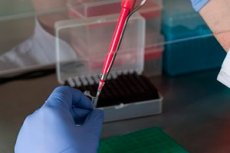Medical expert of the article
New publications
Blood tests for liver tests in a child
Last reviewed: 04.07.2025

All iLive content is medically reviewed or fact checked to ensure as much factual accuracy as possible.
We have strict sourcing guidelines and only link to reputable media sites, academic research institutions and, whenever possible, medically peer reviewed studies. Note that the numbers in parentheses ([1], [2], etc.) are clickable links to these studies.
If you feel that any of our content is inaccurate, out-of-date, or otherwise questionable, please select it and press Ctrl + Enter.

Screening diagnostic tests of the liver in children have their own specifics. Analysis of liver tests for a child is aimed at assessing the functional state of the organ.
The number of tests depends on the doctor's orders and the patient's complaints. That is, there is no established diagnostic norm for children. Tests are selected based on the child's age, growth and hormonal characteristics, the presence of congenital anomalies and chronic diseases of the body.
Technique of implementation
Blood is taken from the heel or vein, depending on the age of the small patient.
Normal liver function tests in children
The interpretation of the analysis values is not identical to that of adults. Let's consider the norms of the main liver indicators depending on the child's age:
- ALT
This enzyme is analyzed simultaneously with AST, allowing differentiation of disorders in the liver and cardiovascular system.
- Children under 6 weeks 0.37-1.21 mkat/l.
- Up to 12 months – 0.27-0.97 mkat/l.
- Up to 15 years – 0.20-0.63 mkat/l.
The results of many laboratory tests in children differ significantly from the established norms for adults. This applies to the analysis of liver function tests. For example, the main marker of bile stasis in adults is a high level of alkaline phosphatase. In children, the activity of this substance is increased, as the body grows. That is, the analysis does not indicate disorders of the hepatobiliary system.
The norm in the results of biochemical screening of the liver in children:
Age of the child |
Index, mkat/l |
||||
ALT |
AST |
GGTP |
ASF |
Total bilirubin |
|
Up to 6 weeks |
0.37-1.21 |
0.15-0.73 |
0.37-3.0 |
1.2-6.3 |
1st day of life – 0-38 2nd day of life – 0.85 4th day of life – 0-171 21st day of life – 0-29 |
Up to 12 months |
0.27-0.97 |
0.15-0.85 |
0.1-1.04 |
1.44-8.0 |
0-29 |
Up to 15 years |
0.20-0.63 |
0.25-0.6 |
0.1-0.39 |
1.35-7.5 |
2.17 |
Blood is taken for analysis from the heel or elbow vein. Before the analysis, it is very important that the child does not eat for 8 hours. This is necessary to obtain reliable results. The number of studies for liver function tests is prescribed by the doctor. The doctor analyzes the results of the examination of the child, the presence of complaints and a number of other factors. The presence of congenital anomalies is also taken into account, which return to normal as the child grows up.
Increase and decrease of values
Increased alanine aminotransferase values are observed in the following cases: acute viral hepatitis, cirrhosis, tumor metastases to the liver, leukemia, non-Hodgkin's lymphoma, Reye's syndrome, liver necrosis, hepatitis, toxic organ damage. Changes in ALT may be associated with diseases of the biliary tract and pancreas, metabolic pathologies, decompensation of heart defects, muscular dystrophy, and body temperature disorders.
- AST
- Up to 6 weeks 0.15-0.73 mkat/l.
- 6 weeks-12 months - 0.15-0.85 mkat/l.
- Up to 15 years 0.25-0.6 mkat/l.
Increased aspartate aminotransferase in the child's blood is possible in the following cases: heart and skeletal muscle diseases, blood diseases. Hepatitis, intoxication, primary hepatoma, cytomegalovirus infection, infectious mononucleosis, acute pancreatitis, hypothyroidism, renal infarction, decreased potassium levels in the blood, Reye's syndrome.
- GGTP
- Children under 6 weeks of age – 0.37-3.0 mkat/l.
- Up to 12 months – 0.1-1.04 mkat/l.
- Up to 15 years – 0.1-0.39 mkat/l.
Increased levels of gamma-glutamyl transpeptidase are most often associated with the following pathologies: hepatitis, cirrhosis, intoxication, hepatosteatosis, cholestasis, liver metastases, cardiovascular diseases, congenital diseases with increased levels of fats in the blood, endocrine disorders. A decrease in the level of GGTP is observed in hypothyroidism, that is, a decrease in the activity of the thyroid gland.
- Alkaline phosphatase
This enzyme is formed in the liver and bones. The maturation and growth of a child occurs due to the active production of alkaline phosphatase.
- Newborns up to 6 weeks – 1.2-6.3 mkat/l.
- Children under 1 year – 1.44-8.0 mkat/l.
- Children from 2 to 10 years old – 1.12-6.2 mkat/l.
- Children from 11 to 15 years old – 1.35-7.5 mkat/l.
Causes of increased ALP in children: viral hepatitis, liver abscess, tumor or obstruction of the bile ducts, infectious mononucleosis. Diseases of the skeletal system, kidneys, leukemia, phosphorus and calcium deficiency, gastrointestinal pathologies, chronic diarrhea, nephrotic syndrome. A decrease in ALP in pediatric patients is possible in case of severe anemia, hypothyroidism, hypophosphatasemia, hypoparathyroidism, as well as growth hormone deficiency during puberty.
- Total bilirubin
- 1st day of life – 0-38 mkat/l.
- 2nd day of life – 0.85 mkat/l.
- 4th day of life – 0-171 mkat/l.
- 21st day of life – 0-29 mkat/l.
- Children under 1 year – 0-29 mkat/l.
- Children under 15 years of age – 2.17 mkat/l.
An increase in bilirubin occurs in the following cases: hemolytic jaundice, hepatic jaundice, congenital viral hepatitis, impaired bile excretion in the liver, and blockage of large bile ducts.
In addition to the above indicators, additional tests may be prescribed to assess the functional state of the liver in a child: total protein, albumin, creatine kinase, coagulogram, immunological tests, etc. The assessment of liver function tests in children is carried out taking into account many factors, so the doctor is responsible for interpreting the test results.


 [
[